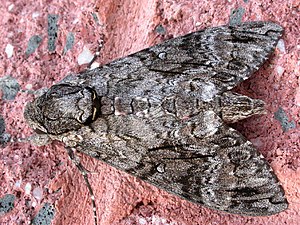Agrius cingulata
| Agrius cingulata | ||||||||||||
|---|---|---|---|---|---|---|---|---|---|---|---|---|

Agrius cingulata |
||||||||||||
| Systematics | ||||||||||||
|
||||||||||||
| Scientific name | ||||||||||||
| Agrius cingulata | ||||||||||||
| ( Fabricius , 1775) |
Agrius cingulata is a butterfly ( moth ) from the family of moth (Sphingidae).
features
The moths reach forewing lengths of 42 to 48 millimeters. They have wing tops drawn in light and dark gray . As the only North American hawk species, they have pink-colored hind wings and alternating pink and black transverse bands on the abdomen. The pink coloring is somewhat variable, but the drawing is not.
In the last stage, the caterpillars have the typical physique of the swarmers. Your anal horn is strong and curved backwards. Caterpillars come in three color variants, two green and one brown. The green caterpillars lack secondary bristling. They have a smooth body surface, have seven pairs of dorsolateral strips and have conspicuous spiracles . The one green form has broad brown colored stigmas that are bordered in black and underlaid again with white. The other shape has a slightly paler basic color and is only slightly patterned. Around the belly legs the animals are dotted with different brown spots. The brown form has a pale beige base color with a very pronounced dark chocolate-brown pattern. Like the green forms, they have dorsolateral stripes and conspicuously colored stigmas. All three forms have striking stripes on the head capsule.
The pupa is light brown to yellowish brown in color and has a smooth, shiny surface. Their proboscis sheath is exposed and is characteristically rolled back. The kremaster is black, distinctly triangular and rough. It ends in a double point.
Occurrence
The species is mainly neotropical and occurs in South and Central America, the Caribbean and Mexico. They can also be found in Florida, the lower Rio Grande Valley in Texas and the southeast of Arizona . Further north it is unclear whether the finds are random visitors or permanently sedentary animals, as the moths like to make long flights but do not reproduce everywhere. They fly north to southern Canada.
Way of life
The adults become active some time after dark. They have been detected on a large number of different flowers by sucking nectar. These are pink catharanthe ( Catharanthus roseus ), Ipomoea alba , petunias ( Petunia ), hook lilies ( Crinum ), common soapwort ( Saponaria officinalis ) and tobacco ( Nicotina ). The moths are also strongly attracted by artificial light sources.
Flight and caterpillar times
The moths fly in southeast Arizona in a generation that occurs during the summer rainy season. In the Rio Grande Valley, the species flies in two generations in spring (April) and autumn (October, November). In Louisiana, the species is recorded year-round, but is most common between May and November. The animals fly similarly in Florida, although it is unclear how many generations are trained per year.
Food of the caterpillars
The caterpillars feed exclusively on morning glory (Convolvulaceae), from which they eat morning glory ( Ipomoea ) most frequently. The species occasionally occurs as a pest on sweet potatoes ( Ipomoea batatas ).
development
The females lay their eggs individually on the leaves of the food plants. The caterpillars are solitary and stay on the underside of the leaves. Pupation takes place in a cave deep in the ground.
supporting documents
Individual evidence
- ↑ a b c d e f g h James P. Tuttle: The Hawkmoths of North America, A Natural History Study of the Sphingidae of the United States and Canada. The Wedge Entomological Research Foundation, Washington, DC 2007, ISBN 978-0-9796633-0-7 .
literature
- James P. Tuttle: The Hawkmoths of North America, A Natural History Study of the Sphingidae of the United States and Canada. The Wedge Entomological Research Foundation, Washington, DC 2007, ISBN 978-0-9796633-0-7 .





